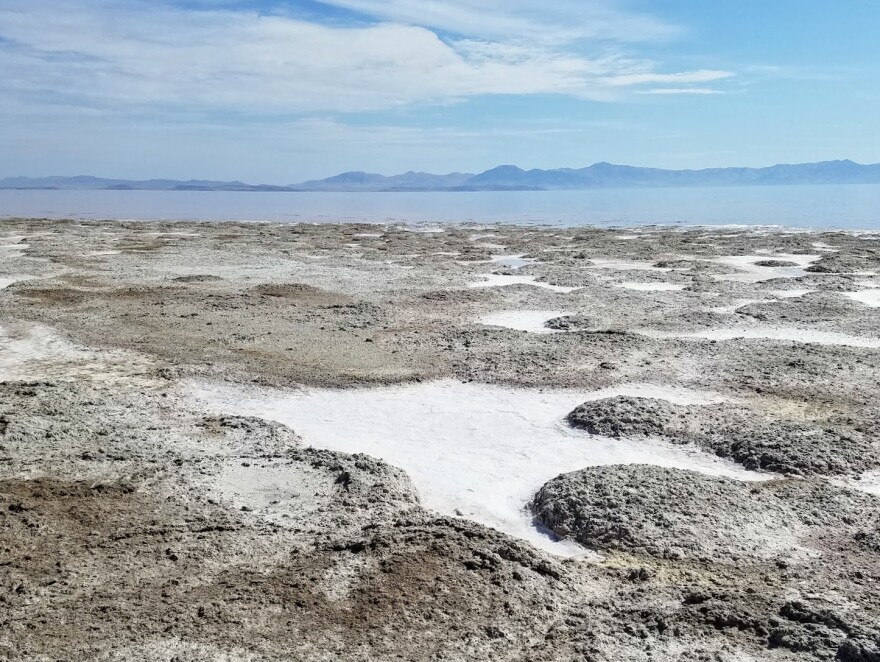Often overlooked, Great Salt Lake is finally getting some much-needed attention from Utah’s legislators. Utah House Speaker Brad Wilson called a summit on January 5th to share the importance of Great Salt Lake and to explore options to reverse its shrinking water levels.
The Davis Conference center in Layton buzzed with excitement as people filtered in to discuss the plight of Great Salt Lake. The bipartisan group came from all manner of backgrounds: environmental groups, mining and aquaculture companies, utilities groups and academics from multiple universities.
Dried saline lake beds across the world tell a harrowing tale of Utah’s future if Great Salt Lake is not restored. Famously, the Aral Sea on the border of Kazakhstan and Uzbekistan dried up almost completely between 1960 and 2010. Its dry lakebed blows toxic dust into nearby communities, doubling cancer rates and increasing infant mortality. Here in the US, California’s Owens Lake dried up in the 1920s, quickly becoming North America’s number one source of dust pollution, emitting 300,000 tons of cancer-causing dust every year. California has already spent $2.4 billion on reducing dust emissions from Owens Lake, a waterbody that is 15 times smaller than Great Salt Lake.
Kevin Perry, an associate professor of atmospheric sciences at the University of Utah, spent two years sampling the 800 square miles of Great Salt Lake’s exposed lakebed, an area the size of Maui, Hawaii for heavy metals and other toxic materials in the sand.
“Every single measurement of arsenic that I took out in the Great Salt Lake exceeded the EPA regional screening levels…if people are exposed to this over a long period of time, then it can lead to significant increases in lung cancer, skin cancer, bladder cancer, and cardiovascular disease and diabetes,” Perry said.
This dust, he explained, gets blown as far north as Cache Valley, south to Provo, and even into Central Utah.
But health problems aren’t the only concern with Great Salt Lake’s receding waterline.
Great Salt Lake supports a variety of industries, and as the lake shrinks, losing these industries may cost Utah billions of dollars each year. The lake supports massive brine shrimp egg harvests which are used to feed farmed fish and shrimp, providing 40 percent of all brine shrimp eggs to aquaculture farms around the world.
Don Leonard, the chair of the Great Salt Lake Advisory Council, drove home the importance of Great Salt Lake to the mineral extraction industry as well, stating “Operating on the south end the lake, US Magnesium produces all, by that I mean 100%, of the magnesium metal that’s produced in this country and 14% of the world supply.”
Environmental consulting companies Martin & Nicholson and ECONorthwest conducted a cost assessment of letting the lake continue to dry, finding that it could cost Utah thousands of jobs and up to $2.17 billion annually or as much as $32 billion over 20 years.
The resounding message at the summit was that the situation is dire. However, researchers and politicians emphasized we are still in a position to avoid the serious disasters ahead should the lake continue to shrink.
Persistent drought has dropped water levels an estimated 20 feet since their peak in the 1980s, 11 of those feet are attributed to human water diversions. Representative Joel Ferry said agriculture currently makes up 80% of Utah’s water use, and with numbers that high, reevaluating irrigation practices could significantly benefit the lake. He presented technological advancements in irrigation and explained his recently introduced instream flow bill, allowing farmers to donate their unused water.
Other progress is being made too. Initiatives like implementing metering on secondary water and drought tolerant landscaping are gaining attention, and in November, Governor Cox allocated $45 million to protecting Great Salt Lake.
Katie Newburn, the Education and Outreach Director for Friends of Great Salt Lake, believes the summit is a huge step in the right direction.
“I think this is the most momentum and the closest we've been to implementing meaningful action from the level of our state legislature, which is incredible,” Newburn said.
Despite the wide range of stakeholders at the meeting, including environmental advocates, there was little talk about the inherent importance of the lake’s ecosystems. But Newburn thought that may be okay in the short term.
“We have maybe not seen as much discussion around the ecological significance of this largest saline lake in the United States and how important it has become as saline lakes are threatened around the world…however, I think when we're discussing the economic benefits and the need to deliver water to this system, we are also discussing the protection of the ecology as well,” Newburn explained.
Yet despite increased interest in protecting Great Salt Lake, water-intensive projects still loom, including the Bear River development project that proposes to divert 220,000 acre-feet of water annually out of the Bear River and into nearby communities. The development would potentially drop Great Salt Lake water levels up to 14 inches.
Bringing awareness to the issues surrounding Great Salt Lake is a much-needed first step in enacting change, and as Utah’s legislature gears up for its 2022 session beginning on January 18th, discussion about current and future Great Salt Lake projections is critical to the endurance of our unique lake that is vital to our health, economy and wildlife.




